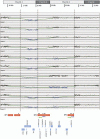Deletions flanked by breakpoints 3 and 4 on 15q13 may contribute to abnormal phenotypes
- PMID: 21248749
- PMCID: PMC3083619
- DOI: 10.1038/ejhg.2010.237
Deletions flanked by breakpoints 3 and 4 on 15q13 may contribute to abnormal phenotypes
Abstract
Non-allelic homologous recombination (NAHR) between segmental duplications in proximal chromosome 15q breakpoint (BP) regions can lead to microdeletions and microduplications. Several individuals with deletions flanked by BP3 and BP4 on 15q13, immediately distal to, and not including the Prader-Willi/Angelman syndrome (PW/AS) critical region and proximal to the BP4-BP5 15q13.3 microdeletion syndrome region, have been reported; however, because the deletion has also been found in normal relatives, the significance of these alterations is unclear. We have identified six individuals with deletions limited to the BP3-BP4 interval and an additional four individuals with deletions of the BP3-BP5 interval from 34 046 samples submitted for clinical testing by microarray-based comparative genomic hybridization (aCGH). Of four individuals with BP3-BP4 deletions for whom parental testing was conducted, two were apparently de novo and two were maternally inherited. A comparison of clinical features, available for five individuals in our study (four with deletions within BP3-BP4 and one with a BP3-BP5 deletion), with those in the literature show common features of short stature and/or failure to thrive, microcephaly, hypotonia, and premature breast development in some individuals. Although the BP3-BP4 deletion does not yet demonstrate statistically significant enrichment in abnormal populations compared with control populations, the presence of common clinical features among probands and the presence of genes with roles in development and nervous system function in the deletion region suggest that this deletion may have a role in abnormal phenotypes in some individuals.
Figures


References
MeSH terms
LinkOut - more resources
Full Text Sources
Research Materials

